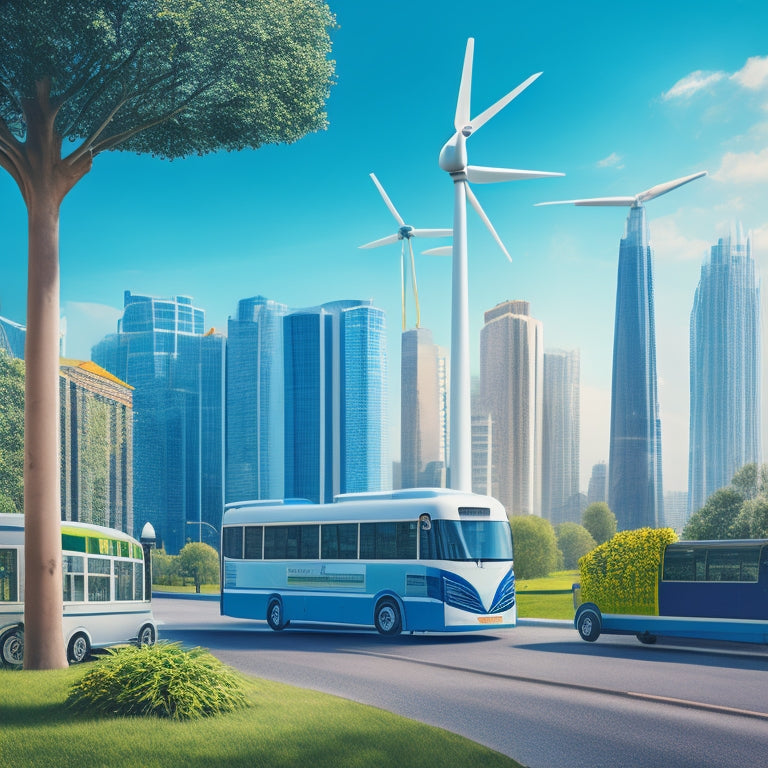
Eco-Friendly Fleet Solutions: 10 Essential Upgrades
Share
You're taking an important step towards reducing your fleet's environmental impact by exploring eco-friendly solutions. By harnessing renewable energy sources, such as wind turbines and solar panels, you can decrease your reliance on non-renewable energy sources. Shifting to sustainable fuels like biodiesel and electric vehicles can further reduce your carbon footprint. Energy-efficient tire technology, aerodynamic trailer upgrades, and energy harvesting brake technologies also offer significant emissions reductions. Implementing green fleet maintenance strategies and incentives like government grants can further boost your eco-friendly efforts. Now, discover how these 10 essential upgrades can help you achieve a more sustainable fleet.
Key Takeaways
• Transition to alternative fuels like biodiesel, ethanol, and renewable diesel to reduce carbon footprint and emissions.
• Implement energy-efficient tire technology and aerodynamic trailer upgrades to improve fuel efficiency and reduce wind resistance.
• Invest in electric vehicles or hybrid fleets for zero-emission alternatives with lower operating costs and reduced emissions.
• Utilize regenerative braking and kinetic energy recovery systems to harness energy and improve fuel efficiency.
• Implement green fleet maintenance strategies, including fleet auditing, scheduled maintenance, and waste reduction programs for peak efficiency.
Harnessing Renewable Energy Sources
As you shift towards eco-friendly fleet operations, utilizing renewable energy sources becomes essential to minimize your carbon footprint and reduce dependence on fossil fuels.
One effective way to achieve this is by harnessing wind energy through Wind Turbines. These turbines convert wind kinetic energy into electrical energy, providing a clean and sustainable power source. By installing wind turbines on or near your fleet's operational sites, you can greatly reduce your reliance on non-renewable energy sources.
Another viable option is Geothermal Systems, which tap into the Earth's natural heat to generate power. This technology leverages heat from underground hot water or steam reservoirs to produce electricity, offering a reliable and eco-friendly energy solution. By incorporating geothermal power into your fleet's operations, you can further minimize your environmental impact.
Solar Panel Installation Benefits
As you consider upgrading your fleet with eco-friendly solutions, you'll find that solar panel installation offers a diverse range of benefits. By harnessing the power of the sun, you'll greatly reduce your fleet's carbon emissions, contributing to a cleaner environment.
Additionally, solar panels can increase your fleet's energy efficiency, leading to cost savings and a reduced reliance on traditional energy sources.
Reduced Carbon Emissions
Installing solar panels on your fleet vehicles can greatly reduce carbon emissions, with a single solar panel system capable of offsetting up to 3,000 pounds of carbon dioxide emissions annually. By reducing your fleet's carbon footprint, you'll not only contribute to a cleaner environment but also benefit from cost savings and potential revenue streams.
Here are some key advantages of reduced carbon emissions:
-
Compliance with emission standards: By reducing your fleet's carbon emissions, you'll be well-positioned to meet increasingly stringent emission standards.
-
Carbon pricing benefits: With reduced emissions, you'll be less exposed to carbon pricing mechanisms, which can help reduce operational costs.
-
Enhanced brand reputation: By prioritizing sustainability, you'll enhance your brand's reputation and appeal to environmentally conscious customers.
- Potential revenue streams: You may be eligible for carbon credits or other incentives, providing a new revenue stream for your business.
Increased Energy Efficiency
By integrating solar panels into your fleet's vehicles, you can greatly reduce your reliance on fossil fuels, resulting in increased energy efficiency and lower operating costs. This upgrade can be especially beneficial for fleets with vehicles that spend a significant amount of time idle or in slow-moving traffic. Solar panels can harness the sun's energy to power auxiliary systems, reducing the load on the engine and decreasing fuel consumption.
| Benefit | Description |
|---|---|
| Fuel Optimization | Reduce fuel consumption by up to 20% through solar-powered auxiliary systems |
| Energy Audits | Identify areas of energy inefficiency and optimize energy usage with data-driven insights |
| Extended Engine Life | Reduce engine wear and tear by decreasing the load on the engine |
| Lower Emissions | Contribute to a cleaner environment by reducing greenhouse gas emissions |
Reducing Carbon Footprint Effectively
As you explore ways to reduce your carbon footprint, you'll want to take into account the impact of green fleet incentives, sustainable fuels, and emissions reduction strategies on your operations.
By understanding these factors, you can develop a thorough plan to minimize your fleet's environmental impact.
Green Fleet Incentives Matter
Embracing green fleet incentives becomes essential in reducing your company's carbon footprint effectively, as regulatory pressures and consumer expectations drive the demand for eco-friendly practices. By leveraging these incentives, you can't only reduce your environmental impact but also benefit from cost savings and improved brand reputation.
Here are some key green fleet incentives to explore:
-
Government Grants: Many governments offer grants for companies that invest in eco-friendly fleet solutions, such as electric or hybrid vehicles.
-
Tax Benefits: You may be eligible for tax credits or deductions for purchasing alternative fuel vehicles or implementing sustainable fleet practices.
-
Low-Interest Loans: Special financing options are available for companies investing in green fleet initiatives, making it more affordable to make the switch.
- Recognition and Certification: Participating in green fleet programs can earn you recognition and certification, enhancing your company's reputation and credibility.
Sustainable Fuels Option
You can greatly decrease your fleet's carbon footprint by shifting to sustainable fuels, which provide a cleaner alternative to traditional fossil fuels. One of the most effective ways to reduce your fleet's environmental impact is by adopting sustainable fuels that meet stringent fuel standards. By doing so, you'll not only reduce greenhouse gas emissions but also contribute to a cleaner environment.
Here's a breakdown of alternative fuel blends that can help you achieve a more eco-friendly fleet:
| Fuel Type | Benefits |
|---|---|
| Biodiesel (B20) | Reduces particulate matter and CO2 emissions |
| Ethanol (E85) | Decreases dependence on fossil fuels, lowers CO2 emissions |
| Compressed Natural Gas (CNG) | Produces fewer emissions, quieter operation |
| Renewable Diesel (R100) | Meets strict fuel standards, reduces CO2 emissions |
When shifting to sustainable fuels, it's important to take into account factors like fuel efficiency, vehicle compatibility, and infrastructure availability. By making the change, you'll be contributing to a cleaner, healthier environment while reducing your fleet's carbon footprint.
Emissions Reduction Strategies
Implementing effective emissions reduction strategies is essential to minimizing your fleet's carbon footprint, and it starts with identifying areas of improvement in your operations. You need to analyze your current practices and pinpoint opportunities to reduce emissions.
Here are some strategies to explore:
-
Optimize routes and schedules: By streamlining your routes and schedules, you can reduce fuel consumption and lower emissions.
-
Improve fuel economy: Regularly maintaining your vehicles and ensuring proper tire pressure can greatly enhance fuel economy, reducing emissions and saving you money.
-
Implement carbon pricing: Assigning a cost to carbon emissions can help you identify areas where reductions can be made and provide a financial incentive to make changes.
- Monitor and track emissions: Regularly tracking emissions helps you identify areas for improvement and measure the effectiveness of your reduction strategies.
Electric Vehicle Charging Infrastructure
As businesses shift to eco-friendly fleets, installing electric vehicle charging infrastructure becomes essential to support the increased demand for electricity.
You'll need to contemplate the design of your charging stations to guarantee efficient and safe charging. A well-designed charging station should prioritize safety features such as overcurrent protection, grounding, and surge protection.
Additionally, you should contemplate incorporating Vehicle to Grid (V2G) technology, which enables electric vehicles to supply energy back to the grid when not in use. This not only helps stabilize the grid but also generates revenue for your business.
When selecting a charging station, look for ones with advanced safety features, such as automatic shut-off in case of an emergency, and contemplate installing them in well-lit, secure areas.
Energy Efficient Tire Technology
Regularly, fleets can reduce their carbon footprint by up to 6% simply by adopting energy-efficient tire technology. When considering upgrading your fleet, focusing on tire technology that reduces rolling resistance, which is a significant contributor to fuel consumption, becomes crucial. By reducing rolling resistance, you'll not only decrease your carbon footprint but also lower your fuel costs.
Here are four key benefits of energy-efficient tire technology:
-
Improved Fuel Efficiency: Energy-efficient tires are designed to decrease rolling resistance, leading to better fuel economy and lower emissions.
-
Ideal Tire Pressure: Proper tire pressure guarantees top performance, reduces wear, and enhances fuel efficiency.
-
Boosted Safety: Energy-efficient tires provide better traction, reducing the risk of accidents and enhancing overall safety on the road.
- Extended Tire Life: By decreasing rolling resistance, energy-efficient tires last longer, reducing maintenance costs and minimizing waste.
Smart Fleet Management Systems
By optimizing energy-efficient tire technology, you can now take your fleet's eco-friendliness to the next level by integrating smart fleet management systems that streamline operations, reduce emissions, and improve overall performance. These advanced systems utilize real-time data and advanced analytics to optimize fleet operations, reducing fuel consumption and emissions.
| Feature | Benefit |
|---|---|
| Vehicle Tracking | Real-time location tracking for improved fleet optimization |
| Route Optimization | Reduced fuel consumption and lower emissions |
| Performance Analytics | Data-driven insights for improved fleet management |
Sustainable Fuel Alternatives Available
When exploring sustainable fuel alternatives, you'll want to evaluate the benefits of adopting biofuels, such as reduced greenhouse gas emissions and dependence on fossil fuels.
Meanwhile, electric vehicles provide an attractive option for those looking to make a significant environmental impact.
Biofuel Adoption Benefits
You can greatly reduce your carbon footprint and lower greenhouse gas emissions by adopting biofuels as a sustainable alternative to traditional fossil fuels. Biofuels offer several advantages that make them an attractive option for eco-friendly fleets.
By switching to biofuels, you can:
-
Reduce greenhouse gas emissions: Biofuels produce substantially fewer emissions than traditional fossil fuels, contributing less to climate change.
-
Lower air pollutants: Biofuels emit fewer air pollutants, improving local air quality and reducing negative environmental impacts.
-
Support domestic energy production: Biofuels can be produced domestically, reducing reliance on foreign oil and supporting local economies.
- Meet environmental regulations: Biofuels can help fleets comply with increasingly stringent environmental regulations, avoiding costly fines and penalties.
Electric Vehicle Options
Electric vehicle options, such as plug-in hybrids and all-electric models, offer fleets a zero-emission alternative to traditional fossil fuels, providing a cleaner, more sustainable solution for transportation needs. As you contemplate shifting your fleet to electric vehicles, you'll want to weigh the benefits of reduced greenhouse gas emissions and lower operating costs.
One key factor to take into account is battery life, as it directly impacts the overall efficiency of your fleet. Look for vehicles with high-capacity batteries that can support long-distance travel and minimize downtime for recharging.
Speaking of recharging, access to reliable charging networks is important for fleets. You'll want to make sure that your vehicles can tap into a wide network of charging stations, minimizing downtime and maximizing productivity.
Aerodynamic Trailer Upgrades Available
Trailer upgrades incorporating aerodynamic components can noticeably reduce wind resistance, resulting in improved fuel efficiency and lower emissions for your fleet. By incorporating these upgrades, you can reduce your fleet's carbon footprint and operating costs.
Here are some aerodynamic trailer upgrades worth exploring:
-
Trailer Skirts: Installing trailer skirts can reduce wind resistance by up to 5%, resulting in improved fuel efficiency and reduced emissions.
-
Airflow Analysis: Conducting airflow analysis can help identify areas of wind resistance and optimize trailer design for improved aerodynamics.
-
Side Fairings: Installing side fairings can reduce wind resistance by up to 3%, resulting in improved fuel efficiency and reduced emissions.
- Rear Tail Fairings: Installing rear tail fairings can reduce wind resistance by up to 2%, resulting in improved fuel efficiency and reduced emissions.
Energy Harvesting Brake Technologies
By capturing kinetic energy generated during braking, energy harvesting brake technologies can greatly reduce your fleet's carbon footprint and operating costs. This innovative technology converts kinetic energy into electrical energy, which can be used to power your vehicles' electrical systems or even recharge their batteries. As a result, you'll see a significant decrease in fuel consumption and greenhouse gas emissions.
Here's a comparison of different energy harvesting brake technologies:
| Technology | Efficiency | Application | Benefits |
|---|---|---|---|
| Regenerative Braking | 30-40% | Electric and Hybrid vehicles | Reduces fuel consumption and emissions |
| Kinetic Energy Recovery | 25-35% | Heavy-duty trucks and buses | Increases fuel efficiency and reduces wear on brakes |
| Electromagnetic Braking | 20-30% | Commercial vehicles | Improves safety and reduces maintenance costs |
| Flywheel Energy Storage | 40-50% | High-performance vehicles | Enhances acceleration and reduces fuel consumption |
Green Fleet Maintenance Strategies
Implementing green fleet maintenance strategies can greatly reduce your fleet's environmental impact and operating costs by extending vehicle lifespan, reducing waste, and optimizing resource allocation. By adopting eco-friendly maintenance practices, you can minimize your fleet's carbon footprint and create a safer, more sustainable operation.
To get started, consider the following green fleet maintenance strategies:
-
Fleet Auditing: Regularly assess your fleet's performance to identify areas for improvement and optimize resource allocation.
-
Vehicle Inspections: Conduct regular vehicle inspections to catch potential issues before they become major problems, reducing waste and downtime.
-
Scheduled Maintenance: Implement a scheduled maintenance program to make sure your vehicles are running at peak efficiency and reduce the need for costly repairs.
- Waste Reduction: Implement recycling programs for used oil, filters, and other materials to minimize waste and reduce your fleet's environmental impact.
Frequently Asked Questions
How Do I Prioritize Eco-Friendly Upgrades on a Limited Budget?
"Can you really afford not to prioritize eco-friendly upgrades? You prioritize by allocating your limited budget effectively, conducting a thorough cost analysis to identify the most impactful upgrades, and strategically phasing in changes."
Can I Retrofit Existing Vehicles for Electric Powertrains?
You can retrofit existing vehicles with electric powertrains through a battery conversion, replacing the internal combustion engine with an electric motor and batteries, ensuring a safe and efficient electric retrofit, but it's essential to follow strict safety protocols and manufacturer guidelines.
Do Eco-Friendly Fleets Require Specialized Maintenance Training?
You'll need specialized maintenance training for eco-friendly fleets, ensuring your team possesses technical competence and green certification to safely handle unique components, such as high-voltage batteries and electrical systems.
Are There Government Incentives for Adopting Green Fleet Solutions?
As you begin on a greener path, you'll find the government's got your back; snagging tax credits and grant opportunities can help offset the cost of eco-friendly fleet upgrades, making your environmentally-friendly endeavors more financially feasible.
How Do I Measure the ROI of Eco-Friendly Fleet Upgrades?
You'll calculate the ROI of eco-friendly fleet upgrades by tracking fuel savings, carbon credits earned, and reduced maintenance costs, then comparing them to the initial investment and anticipated benefits over time.
Related Posts
-

7 Best EV Battery Health Trackers for Homeowners
You can maximize your electric vehicle's performance and lifespan by leveraging advanced battery health trackers that...
-

What Water-Saving Gardens Complement Electric Vehicle Ownership?
As you pair your electric vehicle with a water-saving garden, you're not only reducing your carbon footprint but also...
-

10 Best Sustainable Waste Management Solutions for Green Homes
You're likely unaware that the average green home generates over 2 kilograms of waste daily, but with the right susta...


